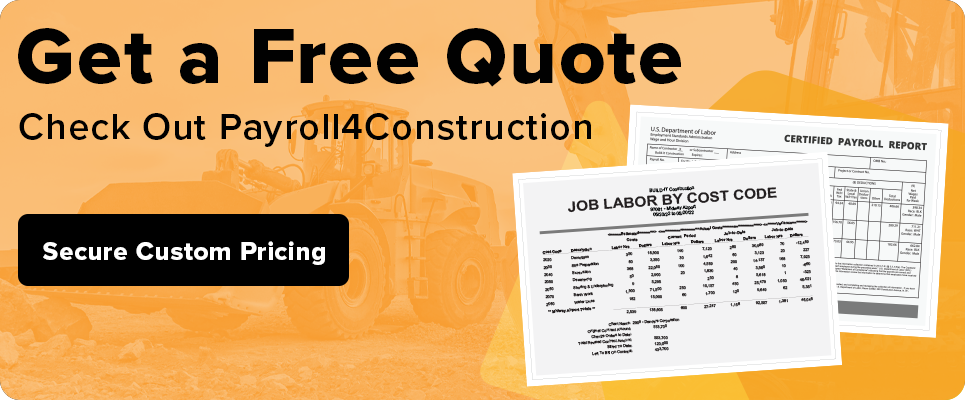
May 24, 2024
Working in multiple states is a great way to attract skilled workers and create more profitable opportunities. However, it does come with its fair set of challenges that contractors need to navigate… namely having to process multi-state payroll.
The issue with multi-state payroll is that a single mistake can have serious legal repercussions such as lawsuits and fines. According to the Independent Electrical Contractors, submitting incorrect payroll amounts can result in penalties that range from 2%-15% of your total payroll amount. This is why maintaining accuracy is crucial for multi-state contractors.
But understanding multi-state payroll can make it significantly easier to manage. And we’re here to help. Here is a breakdown of the ins and outs of multi-state payroll.
Key Takeaways:
- Multi-state payroll is the process of managing payroll for employees working in different states and involves calculating salaries, withholding taxes and deductions and distributing payments while maintaining varying regulations across states.
- Taxes and tracking and reporting payroll tend to be the most challenging as each state differs on what taxes are required to be collected and paid and each state has specific reports required for payroll.
- Outsourcing payroll can help alleviate the burden of managing diverse state regulations and tax laws, allowing your construction business to focus on core operations while ensuring compliance.
Multi-State Payroll in the Construction Industry
Multi-state payroll is the process of managing payroll for employees working in different states. Similar to single-state payroll, multi-state payroll in the construction industry involves calculating salaries, withholding taxes and deductions and distributing payments. Now, what makes multi-state payroll so complex is the varying regulations across states.
Multi-state payroll applies to your business if:
- Your company has offices in multiple states.
- Your business is near a state border, and employees commute from another state.
- You have remote employees living outside your main state.
- Employees travel to other states for temporary assignments.
The more states involved, the trickier it gets, but with a good grasp of the requirements, you can effectively manage multi-state payroll.
Navigating Construction Multi-State Payroll Compliance
When it comes to multi-state payroll there are two main areas that cause contractors the most grief:
- Taxes
- Tracking and Reporting
These areas tend to be the most challenging as each state differs on what taxes are required to be collected and paid and each state has specific reports required for payroll.
Here’s a breakdown of the key things you need to understand to stay compliant with multi-state payroll laws:
1. Source Income Principle
The source income principle determines which state has the right to tax an employee’s income. Essentially, it asserts that the state where the wages were earned has the right to tax them, regardless of the employee’s residency.
For example, you have an employee who lives in Ohio but works in Michigan. In this case, Michigan is the source of their income, so the employer withholds Michigan’s taxes, not Ohio’s. This principle helps determine which state has the right to tax employee wages.
2. Nexus
A nexus is a connection between a state and a business that establishes the state’s right to tax the business. In terms of multi-state payroll for the construction industry, think of nexus as a tie between your business and a state.
This can be anything from a physical office, employees working remotely in that state or even making sales in that state. If you have nexus in a state, you might need to comply with their tax laws, even if your employees don’t physically work there.
3. Reciprocity Agreements
Everyone wants to avoid double taxation. Luckily, some states have reciprocity agreements. This means they won’t tax employees who live in another state with a similar agreement, as long as their employer withholds taxes in their home state.
4. Types of Taxes to Consider
Multi-state payroll involves a juggling act with different state taxes. Here are the main ones to keep an eye on:
- Income Tax: Not all states have this, but most do and require employers to withhold and send it to the state.
- State Unemployment Tax: Some states require employers to withhold this tax from employee pay, while others make it an employer-only cost.
- Disability Insurance Tax: Only a handful of states require employers to withhold this for temporary disability benefits.
- Paid Family and Medical Leave: Some states, have these programs with employer withholding involved.
Withholding rates and rules vary by state, so staying updated is crucial. Be sure to do the research beforehand to know what states require what.
5. State-Specific Rules for Withholding Taxes
Figuring out how much tax to withhold can get tricky. Different states will have different regulations or exceptions to these, but generally these are the rules:
- Income Tax: Based on the source income principle (aka the work state). Most exceptions that exist are for reciprocity agreements and nexus.
- State Unemployment Tax: Withhold for the state where the work is done, unless it’s an employer-only tax in your state.
- Disability Insurance/Paid Family and Medical Leave: This is typically on a state-by-state basis, but typically, the state you operate in will determine your withholding responsibility.
6. Nonresident Taxation Policies
Some states don’t require you to withhold any payroll taxes from employee wages. They might have thresholds for how many days someone works or how much they earn before requiring tax withholding. However, once that threshold is met, you must start withholding the taxes for services performed in the state.
7. Wage and Hour Laws
Multi-state payroll involves navigating a web of federal, state and sometimes local laws. But by understanding these different levels of wage and hour laws, you can ensure your multi-state employees are paid correctly.
Federal: Federal wage and hour laws are standard, as the Fair Labor Standards Act (FLSA) applies to most private-sector employers, regardless of location. This legislation dictates:
- The minimum wage you must pay and how you calculate overtime pay.
- Recordkeeping requirements for employee hours and child labor laws.
Regardless of which state you are in; you will most likely comply with the FLSA.
State: Unlike the FLSA, state wage and hour laws differ significantly. You need to comply with the specific laws for each state where your employees work or where your business operates. In some cases, an employee’s home state laws might apply rather than the state they work in, especially if they travel between states for work.
Local: Some cities and counties have their own wage and hour laws, adding another layer to consider for employees in those areas.
When any of these laws conflict, you generally must comply with the law that provides the most benefits for the employee like higher minimum wage or more generous overtime rules.
8. Tracking and Reporting
Keeping accurate records of hours worked in each state is crucial for proper tax withholding and unemployment insurance contributions. Construction projects can be fluid, so time tracking systems need to be robust and user-friendly to capture this accurately.
On top of that, each state has its own format and deadlines for payroll tax reports and unemployment insurance filings. Missing a deadline or filing incorrectly can lead to fines and delays.
As a business owner, you’ll need to adhere to various reporting and filing requirements to ensure compliance with payroll taxes:
- Federal Compliance: Annually file W-2 forms reporting wages and taxes withheld for each employee.
- Certified Payroll: Certified payroll can impact tax withholding calculations by requiring detailed wage and worker location data for prevailing wage compliance when working on government jobs.
- Prevailing Wage: Prevailing wages require different pay rates for the same job depending on location, impacting payroll calculations.
- State-Specific Reports: Depending on the state, you may be required to file additional quarterly reports.
- Unemployment Insurance: Most states require quarterly filings to report wages and pay state unemployment insurance tax.
- New Hire Reporting: States also mandate reporting of new hires to track child support obligations.
- Local Taxes: Some localities require separate filings for taxes such as local income, school district, or other municipal taxes.
- Deadlines and Forms: Each state and locality may have different deadlines and forms. It is essential to consult your state’s Department of Revenue and Employment website or a tax professional for the correct forms and filing schedules.
- Union Payroll: Union payroll introduces unique union contract rules and potentially varying benefits across different regions, which requires careful consideration during processing.
Simplifying Multi-State Payroll for Contractors
To help manage multi-state payroll, consider the methods that can not only help save time, but also maintain accuracy, compliance and efficiency, such as:
1. Outsourcing to A Construction-Specific Payroll Service
Outsourcing payroll can help alleviate the burden of managing diverse state regulations and tax laws, allowing your construction business to focus on core operations while ensuring compliance. These construction-specific payroll services often have features that will automate tax withholdings and handle multi-state payroll calculations for you while offering an in-house multi-state payroll support team with expertise in construction.
2. Using an Advanced Construction Payroll Software
Advanced software can help automate processes, significantly reducing manual efforts and minimizing the risk of errors. Construction payroll software systems often come equipped with features such as automated:
- Tax calculations
- Compliance checks
- Reporting functionalities
Many payroll software can also offer free reporting options after payroll is run. These reports include:
- Workers’ compensation
- EEO/minority compliance
- New hire
The experts who work for a construction payroll service can also assist with keeping you updated on compliance changes in different states. Staying aware of regulatory changes ensures that your payroll processes remain compliant to avoid the risk of penalties.
3. Employee Self-Service Portals
Employee self-service portals that allow workers to access and manage their payroll information can be extremely beneficial for processing multi-state payroll. These self-service portals enable employees to update personal details, view pay stubs and access relevant tax information independently. This helps guarantee that information is accurate before processing begins.
Manage Multi-State Payroll With Payroll4Construction
Multi-state payroll can be daunting, and there is no one-size-fits-all solution. However, understanding the multi-state payroll requirements can help to streamline your procedures as much as possible. Remember to do your research. Each states taxes and reporting may be different, but knowing what you’re looking for can help you manage multi-state payroll easily.
Consider a specialized construction payroll service like Payroll4Construction. We can handle everything from state tax withholdings, adapting to regulatory changes, maintaining accurate employee records and more.
And with our advanced reporting tool, you can generate free payroll reports including EEO/minority compliance, union, workers’ compensation and more. Our expertise deals with the nuances of state taxes, regulations, and recordkeeping, allowing you to focus on what you do best.
Share Article
Keep on current news in the construction industry. Subscribe to free eNews!


